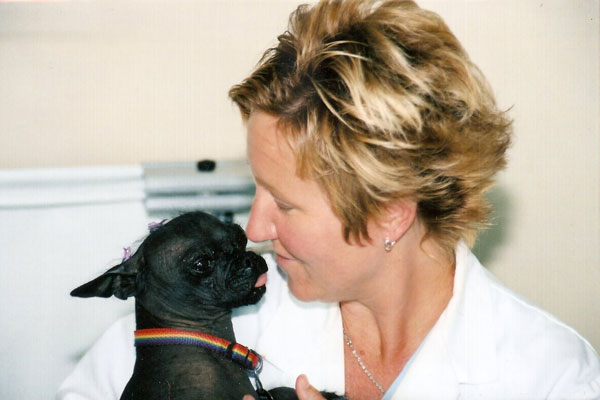
By Teresa Garden, DVM
Most of us are familiar with the pain and inflammation osteoarthritis (OA) can cause. We readily recognize its ravages on older people and older dogs. But new research is confirming OA has become a common disease in young dogs. This is a novel concept to both veterinarians and pet owners. New research is changing the way veterinarians think of arthritis and how we need to educate our clients going forward. Recent studies have shown 40% of dogs (all breeds represented) have OA by 4 years of age. The diagnosis of OA in the research population was confirmed by clinical signs based on veterinary assessment as well as radiographic evidence. The dogs ranged in age from 8 months to 4 years old. And again, 40% of these puppies and young adult dogs had confirmed OA!
Early recognition of arthritis can be difficult for pet owners and veterinarians. But by acting early when symptoms are just a “little deal” problem we can prevent a “huge deal” problem later. By intervening early, the quality of life of dogs can be improved. Since OA is a chronic progressive disease, the goal of treatment and management is to prevent severe symptoms for as long as we can.
Dogs with Stage 1 OA may not have obvious clinical signs. But a thorough history may indicate the dog has some short lasting lameness after physical activity. This often occurs in large and giant breeds of dogs at risk for hip dysplasia, elbow dysplasia, and OCD of the shoulder. Stage 1 OA can be diagnosed by history, physical exam ( decreased range of motion of joints), evaluating posture and gait, and radiographs. Treatment for Stage1 includes starting an omega-3 fatty acid supplement such as Nordic Naturals Omega 3 Pet or Grizzly’s Salmon Oil. A good joint supplement such as Phycox, Dasuquin, or Glycoflex should be implemented as well. Maintaining optimal body weight is a key element of successful treatment. Unfortunately, many young dogs are overweight and predisposed to OA. Weight loss alone will improve mobility in 70% of obese dogs!
Stage 2 or mild OA will present with subtle symptoms. The dog may be slower to rise or to lay down. He may be a little slower when climbing stairs. Routine low to moderate impact exercise is advised in addition to the supplements and weight loss plan discussed above. A non-steroidal anti-inflammatory drug (NSAID) should be incorporated at this point since OA is an inflammatory disease. Galliprant is a good drug of choice because it blocks OA pain and inflammation without disrupting production of prostaglandins. Galliprant also may have less detrimental effects on the dog’s liver and kidney functions. NSAID therapy may only be needed for a short period of time in Stage 2 patients. Once these patients achieve normal body weight and supplements have taken effect, they may be weaned off the NSAID. NSAIDS may only be needed for future “flare ups”.
Moderate arthritis, Stage 3, will cause clinical signs in dogs easily recognized by pet owners. These dogs are slow to rise and lay down. Often, they may groan when doing so. Their gait is slow and stiff. Managing steps or jumping into the car can be a challenge. NSAIDS are now needed on a daily long term basis. The goal is to find the lowest most effective dose of the drug. There are many good NSAIDS approved for use in the dog. Rimadyl, Meloxicam, Galliprant, Previcox, and Deramaxx are a few. Improvement of OA symptoms is seen fairly quickly once an NSAID is employed. If your dog does not respond well to one brand of NSAID, another may do the job. Liver and kidney function need to be monitored every few months while taking these drugs long term. Some dogs with Stage 3 OA will suffer from chronic neuropathic pain. They may benefit from an additional drug such as Amantadine or Gabapentin. Acupuncture and laser therapy may be needed at this point for more targeted therapy of affected joints.
Stage 4, severe OA, patients have great difficulty just doing their normal everyday routine. These dogs need assistance getting up, climbing stairs and getting into the car. It can be very difficult for them to posture to urinate and defecate. They are stiff, painful, and unsteady on their feet. Affected limbs will now show muscle atrophy. Severe OA takes its toll on both the dog and pet owner. These cases are urgent and complex to treat. Severe OA dogs will require much care from their owners. Various modalities will need to be employed to help. Drug therapy may consist of NSAIDS, Gabapentin, Amantadine, and even anti depressants. Acupuncture, laser therapy, alpha-stimulation, and physical rehab are very effective modalities for treating stage 4 OA. Pet owners can be taught therapeutic exercises and massage techniques to help their pets at home. Stem cell therapy is beneficial for afflicted joints but availability is limited and it can be cost prohibitive at the present time.
Osteoarthritis is a chronic progressive disease. OA can limit your dog’s quality of life by impairing simple body functions such as walking, urinating, and defecating. Recognizing and treating OA early is paramount to halting its progression or perhaps even reversing it. Maintaining optimal weight, feeding fresh high quality pet food diets, providing regular exercise, and employing a multi-modal treatment program is key to battling OA which is raging war on 40% of our dogs 4 years old and younger.
Dr. Teresa Garden is chief veterinarian and owner of Animal Health & Healing, a full-service holistic and conventional veterinary practice in the Maplewood/Richmond Heights area. www.AnimalHealthandHealing.com; phone: 314-781-1738.


